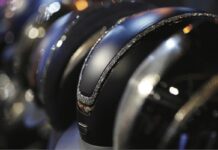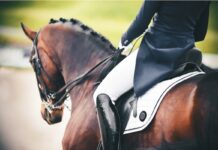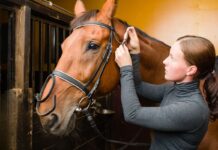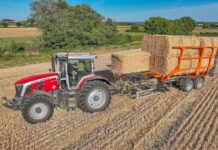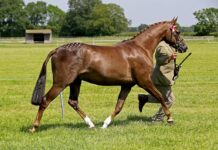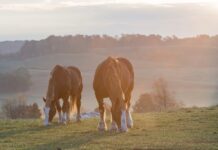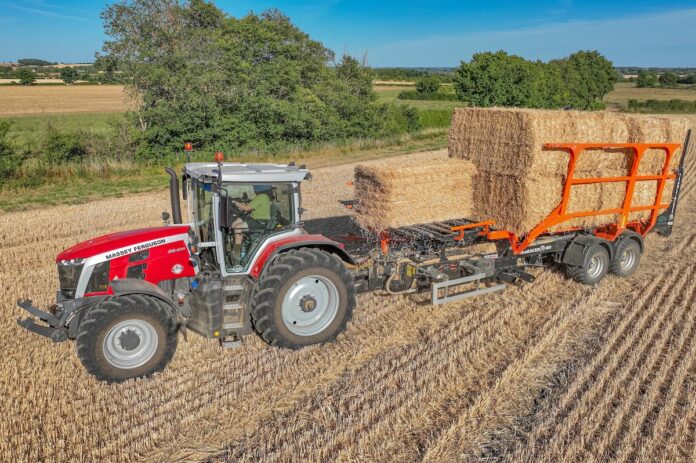Why straw is a bedding for the future
By Dr Katie Williams on behalf of Sundown Products
Equine welfare is widely accepted to be the most important Equine welfare aspect of how we manage our horses today. The sustainability of materials used for things like feed and bedding is however, an increasingly important consideration too. As all industries are being tasked with helping to achieve governmental targets of net-zero carbon emissions, the credentials of different bedding materials are being scrutinised more closely. These two factors are key reasons why straw is a bedding choice for the future.
Promoting equine welfare
A range of studies have been carried out around the world that highlight how the type of bedding we use in the stable can have a significant impact on our horses’ welfare. Bedding type and depth have been shown to influence how long the horse spends lying down which may also affect their sleep quality.
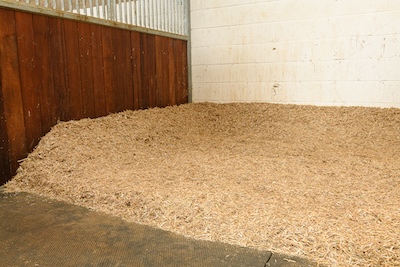
A Polish study compared straw to peat and crushed wood pellets and found horses spent more time lying down when bedded on straw1. Similarly, a German study compared straw with wood shavings and straw pellets, bedding types more commonly used in the UK, and found that horses again spent more time lying down when bedded on straw2.
The researchers did note however, that they followed the manufacturer’s recommendations and used a bedding depth of 5cm when using the straw pellets which may not have been deep enough to encourage horses to lie down. This suggestion is supported by the findings of Greening et al.,3 who found that the depth of straw bedding impacted behaviour. The amount of time horses spent lying down reduced when bedding depth was thinner (5cms versus 15cms).
Additional welfare benefits from bedding on straw
In addition to encouraging horses to lie down, bedding on straw appears to have other benefits for a horse’s welfare. Researchers are advocating the use of edible bedding as it allows horses to forage and spend more time browsing which satisfies their inherent drive to eat and has benefits for the health of their digestive system.
As a herbivore, the horse has evolved to eat relatively low nutritional feedstuffs such as forages, but needs to eat relatively large amounts in order to meet their nutrient and energy requirements. If horses have access to feed materials that are more energy dense, such as higher quality grass in the pasture, they still keep eating and consequently put on weight. One of the reasons horses and ponies in the UK are commonly overweight is because our pasture and forages are too good! It is therefore often necessary to restrict the amount of high energy forages the horse consumes which can impact overall eating time.
When limited amounts of forage are fed in just two or three offerings a day, horses can be without access to forage for up to nine hours every day. The recommendation is not to exceed six hours between eating, and ideally no more than four hours, to reduce the risk of issues like gastric ulcers and colic4. So how does straw as a bedding material have a role to play?
A relatively large study carried out in Germany5, observed the behaviour of 104 horses bedded on straw or non-edible bedding (shavings). In comparison to horses on straw, those on shavings consumed their evening forage meal much quicker. This was largely due to the fact they didn’t stop eating their forage to explore and browse their bedding, compared to those bedded on straw, who did. The authors concluded “the need of the horse to eat continuously is a high priority, and if access to roughage such as straw bedding is limited, it alters behaviour to the detriment of their welfare”.
A smaller study conducted in the UK6 compared 10 horses with the group, split half on shavings and half bedded on straw. Again, there was an increase in time spent eating; 33% for those bedded on shavings and 36% for those on straw.
Are there concerns amongst horse owners about bedding on straw?
Unfortunately some concerns exist amongst horse owners but these are being dispelled as an increasing number of vets and researchers advocate for the benefits of straw bedding, not least Imogen Burrows, Chair of the British Equestrian Veterinary Association (BEVA) Ethics and Welfare committee. This is a really significant step forward in helping to address and allay concerns amongst horse owners. It is important to note that there is no published research showing a direct causal link between horses browsing on straw bedding and impaction colic but clearly, if a horse or pony gorges on straw then the risk is increased. The key point is the amount of straw the horse or pony consumes at any one time. Browsing on bedding in addition to the forage ration is not likely to present any issues, after all, straw is a commonly used ingredient in lots of chopped fibre feeds.
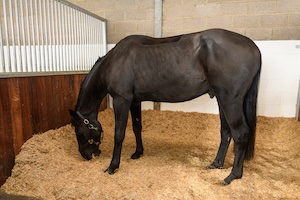
different fibre sources
Horses and ponies on very limited amounts of forage, such as for weight management reasons, are most likely to gorge on a straw bed and so it is recommended to introduce them to straw bedding gradually and monitor their eating behaviour closely. This can be done by putting a small amount of straw bedding into an area of the stable and monitoring whether any is consumed, or the new straw bedding can be mixed with the existing bedding and a gradual change made over time. The novelty of a new bedding is likely to wear off, so starting with small amounts for a few days and then reviewing is a sensible approach. If there are any concerns, horse owners should discuss with their vet before trying straw.
Another myth is that straw is often said to cause gastric ulcers. This originates from the findings of a study from Scandinavia which have frequently been misinterpreted. Straw was identified as a risk factor for ulcers if it was the sole or majority forage used. Subsequent studies have shown that even when straw is included at up to 50% of the total forage ration, there was no increased risk of ulcers7. A horse browsing on their straw bedding is not likely to be consuming anywhere near the level that could be considered a risk factor for ulcers.
It is important to consider that like any forage, straw could contain other plant material so care needs to be taken in relation to naturally occurring prohibited substances (NOPS). NOPS can be found in plants such as poppies and Thornapple, both of which are grown in gardens as ornamental plants but can pop up as ‘volunteers’ in fields. Sourcing straw bedding from companies that understand the potential risks of NOPS is important for those competing or racing under rules.
Concerns about the hygienic status of straw can also put some people off using straw as a bedding. Sourcing straw bedding that has been dust-extracted addresses these concerns, but be aware that not all packaged straw bedding products have been dust- extracted. Check with the manufacturer as to what level of dust-extraction has been carried out.
A sustainable bedding choice
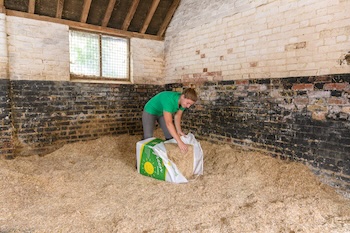
Both the British Horseracing Association (BHA)8 and British Equestrian (BE)9 have set out their intention to reduce carbon emissions in equestrian sport. In studies carried out so far on stud farms, feed and bedding are key areas of a yard’s carbon footprint10. As straw is naturally sun-dried in the field, it compares favourably with other materials that require artificial heat in the drying process and, as it is a co-product from agriculture, it is highly sustainable with a low carbon footprint.
Straw is easily compostable and so is particularly beneficial in overcoming waste management - one of the key challenges associated with running large yards - disposal of the muck heap! A horse weighing 400-500 kg excretes 19-30 kg of dung and urine on average per day. A Scandinavian study11 compared the nutrient cycling properties of three bedding materials, peat, wood shavings and pelleted straw, measuring the material’s composting characteristics and ability to store nutrients rather than leaching them into the environment.
The study revealed manure with straw bedding had superior composting characteristics compared to the other bedding types. This makes it a great choice both for the yard and a benefit to the farmer taking it away. If the yard has to manage the muck heap on-site then the fact that straw rots down quicker than shavings is really helpful for keeping the size of the muck heap under control.
In addition to the benefits for the horse and the environment, straw is also a great value bedding option. It therefore really does appear to be a bedding for the future.
References
- Kwiatkowska-Stenzel, A., Sowinska, J. and Witkowska, D. (2016) The effect of different bedding materials used in stable on horses behavior. Journal of Equine Veterinary Science, 42: 57-66
- Werhahn et al., (2010) Effects of Different Bedding Materials on the Behavior of Horses Housed in Single Stalls. Journal of Equine Veterinary Science, 30(8): 425-431
- Greening, L., Downing, J., Amiouny, D., Lekang, L. and McBride, S. (2021) The effect of altering routine husbandry factors on sleep duration and memory consolidation in the horse. Applied Animal Behaviour Science, 236.
- Luthersson, N., Hou Nielsen, K., Harris, P. and Parkin, T. (2009) Risk factors associated with equine gastric ulceration syndrome (EGUS) in 201 horses in Denmark. Equine Veterinary Journal. 41(7) 625-630.
- Baumgartner, M. Boisson, T., Erhard, M.H. and Zeitler-Feicht, M.H. (2020) Common feeding practices pose a risk to the welfare of horses when kept on non-edible bedding. Animals. 10, 411
- Greening, L., Shenton, V., Wilcockson, K. and Swanson, J. (2013) Investigating duration of nocturnal ingestive and sleep behaviours of horses bedded on straw versus shavings. Journal of Veterinary Behaviour. 8, 82-86
- Jansson et al., (2021) Straw as an Alternative to Grass Forage in Horses—Effects on Post-Prandial Metabolic Profile, energy Intake, Behaviour and Gastric Ulceration. Animals. 11.
- British Horseracing Authority, (2022) Summary findings published from initial research into environmental sustainability in British racing. Available at: https://www.britishhorseracing.com/press_releases/summary-findings-published-from-initial-research-into-environmental-sustainability-in-british-racing/. (Accessed 2 April 2025).
- British Equestrian (n.d.) Environmental Sustainability. Available at: https://www.britishequestrian.org.uk/getInvolved/environmental-sustainability-1. (Accessed 2 April 2025).
- ADAS (2023) Guidance for Sustainable Land Management on Stud Farms. Available at: https://adas.co.uk/projects/sustainable-land-management-on-stud-farms. (Accessed 2 April 2025).
- Keskinen et al., (2017) Recycling nutrients from horse manure: effects of bedding type and its compostability. Agricultural and Food Science, 26: 68-79



